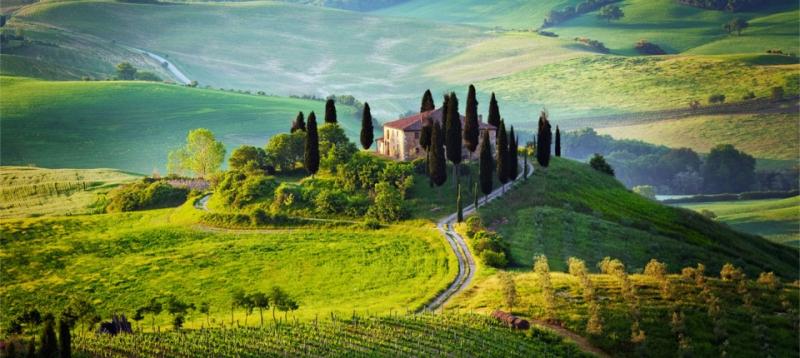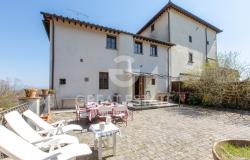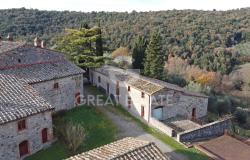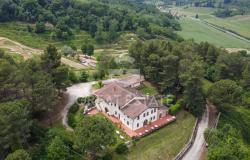Tuscany with its western Tyrrhenian coast, hillside vineyards and abundant sunshine produces fine wines and to know some of the history of its winemaking definitely adds a little flavour.
The wines of Tuscany have worldwide acclaim. It has been recorded as early as the 8th Century BC that Etruscan viticulture was thriving. Amphora remnants have shown to contain wine, apparently a strong wine which was diluted and stored underground in terracotta jars. Tuscan wine was exported to Southern Italy and Gaul, even the Greeks wrote about Tuscan wine, though they themselves were bringing wine to Southern Italy.
These were the days of the gods of wine and viticulture, who go by many names,’ Dionysus’ (Greek) or Liber (the free one) and sometimes Bacchus (Roman). After the fall of the Roman Empire and through the Middle Ages it was the monasteries that were the greatest users of wine. Landowners fell into a practice called ‘mezzadria’ or halving whereby the landowner supplied the land and resources in exchange for half of the crop from the landholder.
In 1282 a guild was formed to exercise control on the way wine was produced and sold. The guild was called Arte dei Vinattieri. No wine was allowed to be sold within 100 yards of a church and it could not be sold to children or prostitutes!
The vines
Originally the cultivar was Vitis vinifera sylvestris, the wild vine that was used by the Etruscans. Today there are many more, ‘Sangiovese’ is Tuscany’s signature grape but here are others ‘Can aioli’ ‘Malvasia’, Colorino’. ‘Mammolo’ to name a few.
The flavour of the wine is a result of the conditions it grows in, for example sangiovese likes abundant sunlight and therefore the hillsides are perfect along with the varying altitudes, which determines the acidity and sugar content of the grapes. Tuscany is divided into regions and the geographical conditions of each region influences the wine produced there. Bolgheri, Carmignano, Chianti, Montalcino wines all have their own unique flavour.
The reds
The earliest wine known from Tuscany is the 14th century Vino Nobile di Montepulciano produced in the southeast. The famous Brunello di Montalcino uses the sangiovese grape and comes from the area around Montalcino, south of the Chianti Classico zone ,where it is warmer and drier, thus making the flavour of the grapes more intense.
Today over 200 growers produce 333000 cases of Brunello! It was also the first wine to receive the DOCG (Denominazioni di origine controllata e garantita) classification. Brunello di Montalcino is a powerful red, a top wine, good with the traditional bistecca alla fiorentina.
The Chianti region in central Tuscany has different zones and extends to Florence and Pisa. The most noted wine is probably Chianti and it has certainly the highest yield as 8 million cases of Chianti were produced last year using 75% sangiovese grapes. Wine makers began experimenting with the process of governo which helps fermentation and stability by adding partially dried grapes to speed up fermentation to give the yeast a new sugar source. The process helps to stabilise the wine.
The whites
Although 80% of Tuscan wines are red the white wines are some of the finest.Vin Santo, which means holy wine, is a desert wine and is often made from Trebbiano or Malvasia Blanco grapes. The grapes are laid on straw and allowed to evaporate. The wine can be dry or very sweet depending on the process. Vernaccia di San Gimignano is one of Tuscany’s finest white wines, using the vernaccia grape. It received its DOC ratings as early as 1966. Passito (desert wine) is made through the appassimento (raisinated) process and stored in oak barrels for 5 years, often served as an aperitif it has a very high alcohol content and is rated as a liqueur.
Super Tuscans
Super Tuscan’s are generally Tuscan wines that have not been produced under the specific DOC regulations.
It all began in the 1940’s when the Marchese Mario Incisa della Rocchetta arrived in Bolgheri, the seat of the Super Tuscan wines. The Marchese imported Cabernet Sauvignon from Bordeaux and developed his wines to create Sassicaia on the estate Tenuta San Guido. The nephew of the Marchese released a wine called Tignanello in the 1970’s which was one of the first Super Tuscans. In 1992 a category was created called Indicazione Geografica tipica (IGT) which allowed for an indication of quality levels within the broad term of Vino di Tavolo, previously considered an inferior wine.
Notable Tuscan Wines
Whether your preference is white, red or rose’ there is a wine suitable for every course on every culinary menu and disappointment is rare.
Tuscany has the climate, the geography, water and a yielding heart! Some wonderful fine wines need to be mentioned with their qualities so that the discerning buyer may choose well.
Tenuta San Guido Sassicaia Bolgheri (a Super Tuscan) is red and fruity; Rosso di Montalcino , easy drinking and fresher than its big brother Brunello di Montelcino which is a deeper full bodied red; Carmignano, a blend of sangiovese with cabernet sauvignon; Vino Nobile di Montepulciano, a Riserva wine with an oaky flavour and very versatile; Chianti Classico Riserva(DOCG) has a cherry flavour and is nicely aged ; Elba Aleatico Passito , a sweet red (DOCG 2010) ;Vernaccia San Gimignano (DOCG 1993), a crisp dry white , grown at high altitude, over 500 metres in the hills surrounding San Gimignano and Vin Santo a white, mostly sweet wine but sometimes dry like a sherry ,often called a straw wine because the grapes are dried on straw mats prior to fermentation. This wine is very good with almond biscuits. After much food and wine there is always the Grappa di Toscana (made from dry skins and pips) which can be taken as a digestive!
Tuscan wines are a treasure in themselves and even more so when sampled in the beautiful Tuscan landscape of hills, cypress, blue skies and visions of the god of viticulture looking down, smiling over the success of the vineyards in his domain.













